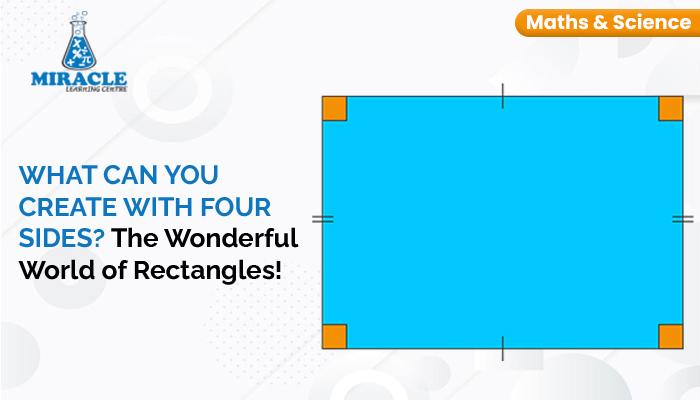When it comes to shapes, the rectangle stands as an epitome of balance, simplicity, and functionality. Its four sides, with opposite sides being equal and parallel, define its distinct identity. This fundamental geometric figure has intrigued mathematicians, architects, and artists alike for centuries, owing to its unique properties and applications.At our Maths Tuition Centre, we delve into the captivating realm of shapes, uncovering the significance and applications of fundamental figures like the rectangle.
What is a Rectangle?
A rectangle is a quadrilateral with four right angles, where opposite sides are parallel and of equal length. It’s a special case of a parallelogram, where all angles are 90 degrees, making it a regular quadrilateral. This shape’s symmetrical and straightforward nature has made it a cornerstone in various mathematical concepts.
Elements of a Rectangle
A rectangle, with its defining attributes, holds a unique essence in geometry, encapsulating various key elements that shape its identity and utility.
Length of Rectangle: This dimension defines the longer side or the vertical span of a rectangle, anchoring its vertical presence and forming the basis for its proportions and spatial orientation.
Breadth of Rectangle: The breadth, synonymous with width, signifies the shorter side or the horizontal expanse of the rectangle, contributing to its width and foundational stability.
Diagonal of Rectangle: The diagonal, a connecting line between opposing vertices, acts as a fundamental internal structure, establishing symmetry and harmonizing the relationship between the rectangle’s corners.
Properties of a Rectangle
A rectangle, a closed geometric figure, possesses four sides where each angle formed by adjacent sides measures 90°. This fundamental shape displays an array of distinctive properties that make it an intriguing subject within geometry.
Key properties of a rectangle include:
- Quadrilateral Nature: A rectangle is classified as a quadrilateral due to its four sides and four angles.
- Equal and Parallel Opposite Sides: The opposing sides of a rectangle are not only equal in length but also run parallel to each other.
- Interior Angles of 90°: At every vertex within a rectangle, the angle formed is a perfect 90 degrees.
- Sum of Interior Angles: The total of all interior angles in a rectangle amounts to 360°, a result of its four right angles.
- Diagonals Bisect and Equal Lengths: The diagonals of a rectangle intersect each other at their midpoints, dividing each other equally. Additionally, these diagonals share an identical length.
- Pythagorean Theorem Application: The length of the diagonals can be calculated using the Pythagorean theorem, where the diagonal with sides ‘a’ and ‘b’ is given by the formula: Diagonal = √ (a2 +b2)
- Rectangles as Parallelograms: Due to its parallel sides, a rectangle is also termed a parallelogram.
- Rectangles vs. Parallelograms: While all rectangles are classified as parallelograms due to their parallel sides, it’s crucial to note that not all parallelograms are rectangles. Rectangles are a specific subset of parallelograms distinguished by their 90-degree angles and congruent diagonals.
These properties collectively define the essence of a rectangle, showcasing its symmetry, balance, and geometric elegance. Understanding these distinct characteristics aids in the exploration of its applications in various mathematical and practical contexts.
Formula of a Rectangle
Understanding the formulas connected to rectangles simplifies problem-solving and aids in various mathematical applications.
Area of Rectangle:The area of a rectangle is calculated by multiplying its length by its breadth. Mathematically, this is represented as: Area = LengthxBreadth
Perimeter of Rectangle:To find the perimeter of a rectangle, add twice the length to twice the breadth. The formula for the perimeter is: Perimeter = 2 (Length+ Breadth)
Diagonal of Rectangle:The diagonal of a rectangle is determined by using the Pythagorean theorem, considering the length and breadth as the sides of a right-angled triangle. The formula to calculate the diagonal is: Diagonal = √(Length2 + Breadth2)
A square is a special case of a rectangle where all sides are equal. In essence, a square is a particular type of rectangle where the length equals the breadth. This relationship emphasizes the versatility of rectangles in transitioning to other shapes.
Get More Insight in Our Maths Tuition
Enhance your understanding of geometric wonders at our state-of-the-art Maths tuition centre. Our dedicated Maths Tutors employ tailored teaching methods, ensuring a comprehensive grasp of shapes, including the versatile rectangle. With a curriculum designed to delve into the intricacies of geometry, our Maths Tuition stands as a beacon for those seeking clarity in mathematical concepts.
At our Maths Tuition centre, we prioritize a personalized approach, catering to individual learning styles. Our experienced Maths Tutors not only impart knowledge but also foster critical thinking and problem-solving skills. Through interactive sessions and practical applications, students delve deeper into the properties and formulas associated with rectangles, unlocking a world of mathematical possibilities.
Join our Maths Tuition to explore the boundless realm of shapes and dimensions. Our Maths Tutors are committed to nurturing a solid foundation in geometry, empowering students to excel and thrive in their mathematical journey.
Conclusion
The foundational role of rectangles in mathematics spans architectural design to intricate problem-solving. Understanding their elements, properties, and formulas enhances appreciation for their elegance. At our Maths Tuition, we unravel the practicality of rectangles, empowering learners to navigate the structured world of geometry. Embrace the versatility of rectangles, discovering their significance in diverse fields. Join us to explore these foundational shapes and unlock countless possibilities within our Maths Tuition programs.


